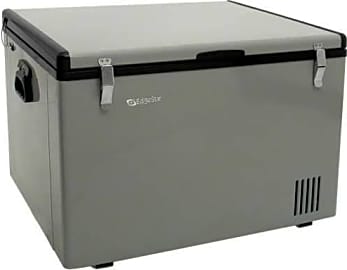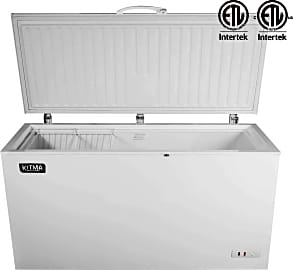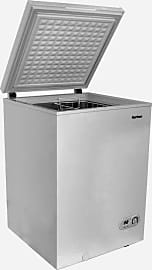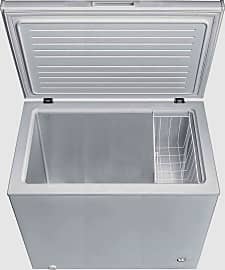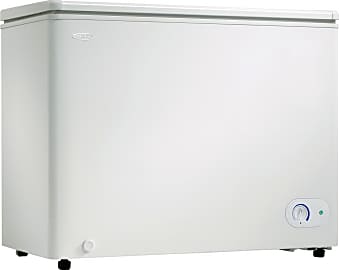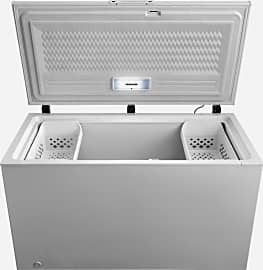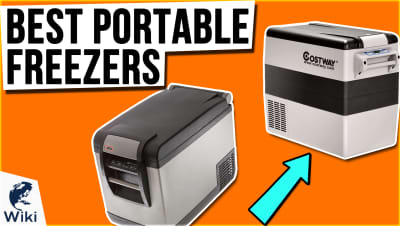The 9 Best Chest Freezers

This wiki has been updated 39 times since it was first published in February of 2015. When there's a sale at the grocery store, or you're interested in bulk food prep, having a deep freezer can help you save money and provide flexibility with your food storage options. The models we've selected include some that are quiet, unobtrusive, and energy-efficient, so they'll be a welcome addition to any large household, and we've even included some portable options that will fit in an RV. When users buy our independently chosen editorial recommendations, we may earn commissions to help fund the Wiki.
Editor's Notes
December 03, 2020:
We removed the Dometic Electric because of concerns about its quality and durability, and added the Galanz GLF70CWED017. This new addition offers 7 cubic-feet of space, and costs less than similar-sized models. It also has rolling casters, making it a great choice for those who might need to periodically move it around the garage or basement.
It’s important to periodically defrost your freezer whenever ice buildup accumulates to a ¼-inch thick. This frost can reduce the efficiency of the freezer, and result in higher energy costs. Frost buildup can also take up valuable food storage space.
Defrosting your chest freezer must sound intimidating, but it’s a pretty straightforward process. First, turn off the unit and unplug it. Then, remove all the food inside, which can be either stored in another freezer or fridge, or temporarily inside insulated bags or coolers. Then you simply wait for the ice to melt and flow out of the freezer drain. If you like, you can speed up the process by chipping away at the ice with a wooden spatula. Make sure you never use anything metal to scrape, as it can damage the inside of the freezer. Once the ice is melted and drained, you can plug your freezer back in, let it reach its proper cooling temperature, and then it can be refilled.
If you’re tight on floor space, but still want a freezer that can store a decent amount of food, you might want to consider an upright freezer. These are just as functional as the chest models listed here, but have a much smaller footprint.
Or, if you’re interested in taking frozen foods camping, on a road trip, or a tailgate, one of these portable freezers could be a better choice.
December 19, 2019:
We replaced the Haier models previously on this list due to declining durability reported by users. The Arctic King is a reliable option that is a reasonable size for everyday home usage without having to relegate the unit to a garage or basement to find space for it.
We also did add the Frigidaire 14.8. This capacity isn't needed for the average family but for homes that acquire their meats in bulk, the Frigidaire will keep everything at a constant temperature.
Portable choices like the Edge Star FP630 and the Dometic Electric offer some versatility for those who don't need extra freezer storage year round, and might want to use it for other things like road trips or RVs.
A Few Words On Food Safety
And contrary to common perception, many chest freezers are surprisingly affordable.
Freezing not only keeps foods safe for long periods of time, but can also save you money. Many types of food can be safely stored at freezing temperatures, which allows a consumer to buy everything from meats to breads to fruits in greater bulk, thereby reducing costs and requiring fewer trips to the grocery store.
To illustrate the benefits of freezing, consider a few figures established by government research: Ground meats, such as beef and turkey, have a safe life in the refrigerator of about 48 hours, but they are safe when stored in a freezer for three to four months. Poultry, such as fresh chicken, will last for only two to three days in the fridge, yet it can be stored frozen for as long as an entire year. Frozen bread, when it has been wrapped tightly to preserve internal moisture, can be stored for as long as six months.
Freezing foods prevents the buildup of potentially harmful bacteria, so if you don't plan to eat a food shortly after acquiring it, freezing it is the best way to ensure it does not go to waste. A chest freezer is a great way to safely extend the life of foods without monopolizing all the space in your kitchen freezer. And contrary to common perception, many chest freezers are surprisingly affordable. Unlike the freezer built into a refrigerator, a deep freezer holds its cold temperatures with impressive stability, helping to prevent dangerous thawing and saving energy at the same time.
Choosing The Right Chest Freezer
Almost all chest freezers feature a similar design. The tend to be top-loaded cubes or rectangles, and more often than not they are white in color, as white rejects the most heat, helping to insulate the freezer's contents. (You don't buy a chest freezer for aesthetics, you buy it to keep food frozen.)
Beyond size and cost, you may consider the locking capabilities of some chest freezers, especially for an outdoor unit or one used in a commercial location.
Choosing the right chest freezer to suit your needs really comes down to little more than capacity and price. If you are a serious hunter or fisher who wants to preserve many pounds of meat, then by all means invest in a larger chest freezer; many are available with a capacity of more than 15 cubic feet, and can even serve well in a commercial capacity, storing products such as ice cream or bags of ice at your grocery or convenience store.
On the other hand, if your home just needs a bit of extra freezer space, there are plenty of units that offer fewer than five cubic feet of interior capacity and that won't break the bank. These smaller capacity freezers also require much less real estate; many occupy less than four square feet of floor space, so they can be easily tucked into any garage or basement or could even fit into a corner of the kitchen.
Beyond size and cost, you may consider the locking capabilities of some chest freezers, especially for an outdoor unit or one used in a commercial location. If you have specialized needs, such as for storing bait or foods with specific temperature requirements, make sure the chest freezer you choose allows for easy and reliable temperature adjustment settings.
Chest Freezer Use And Maintenance
Chest freezers fall squarely into the category the United States Commerce Department would call "durable goods." With a bit of care and occasional maintenance, a good chest freezer should last for many years, so don't worry if you decided to splurge and buy one of the more expensive models, you'll be enjoying it for many years, provided you care for it properly.
Dry the freezer fully using paper towels, then plug it back in.
It might seem ironic, but the best thing you can do for a freezer is to occasionally thaw it out completely. Defrosting and thawing a freezer helps to make sure its components, such as air vents and coils, aren't compromised by a buildup of ice and frost. You should plan to thaw out your chest freezer at least twice a year. Spending the hour or so involved in the process twice annually may well extend the life of your chest freezer by many years, so think of the process as trading a little time for a lot of money.
The thawing process is quite simple: just empty your freezer (into a cooler or into another fridge or freezer), unplug the unit, prop the door wide open, and wait for it to thaw. (You can direct air into the freezer using a fan to accelerate the process, and scraping ice off the walls using a dull knife or an ice scraper designed for a car windshield can help.) Once the freezer has fully defrosted, make sure to sop up all the liquid within it and then thoroughly wipe down the freezer using an anti-bacterial cleaner. Dry the freezer fully using paper towels, then plug it back in.
Let the chest freezer reach its nominal cold temperature again before you refill it with foods and bags of ice.


